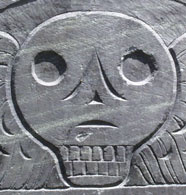|
|
| The crown, or upper portion of the stone, holds pictorial representations of spirits. One of the most common representations is the skull, or death's head, often pictured with wings. Early representations tend to portray skulls with empty eye sockets and rows of teeth. Later representations — sometimes called a soul effigy — became more cherubic, and some even angelic. The symbolic significance of these pictures is a matter of dicussion. At its simplest, the skull portrays death. The addition of wings may suggest the soul's migration and a resurrection; or the spirit that flies from the body, leaving death. |
 |
| Mrs. Malcom (1762) |
 |
|